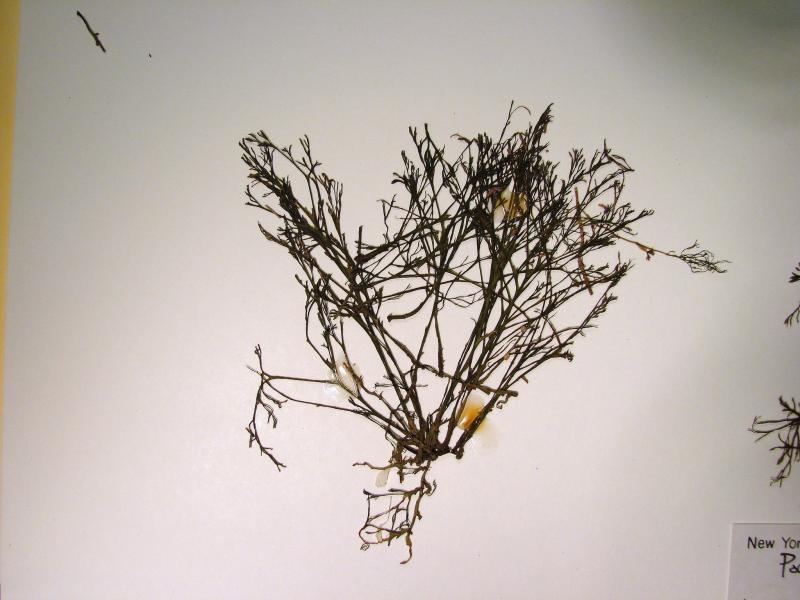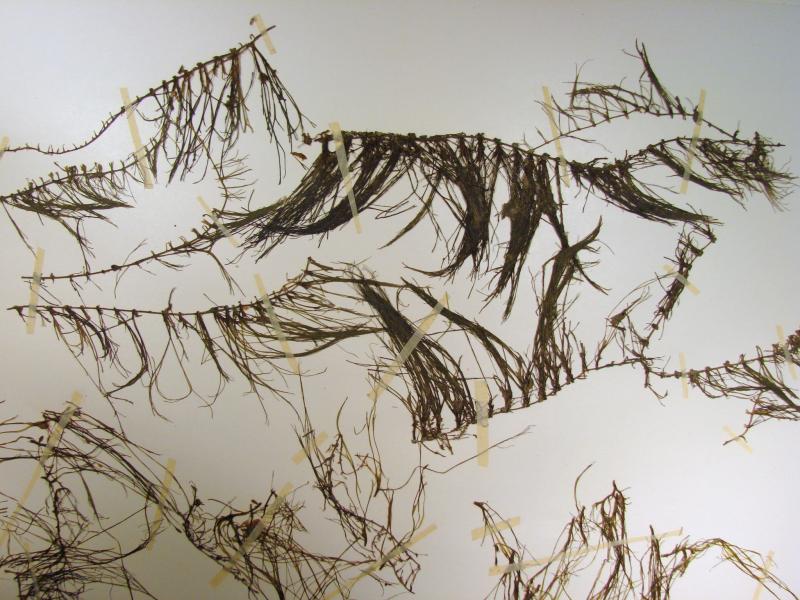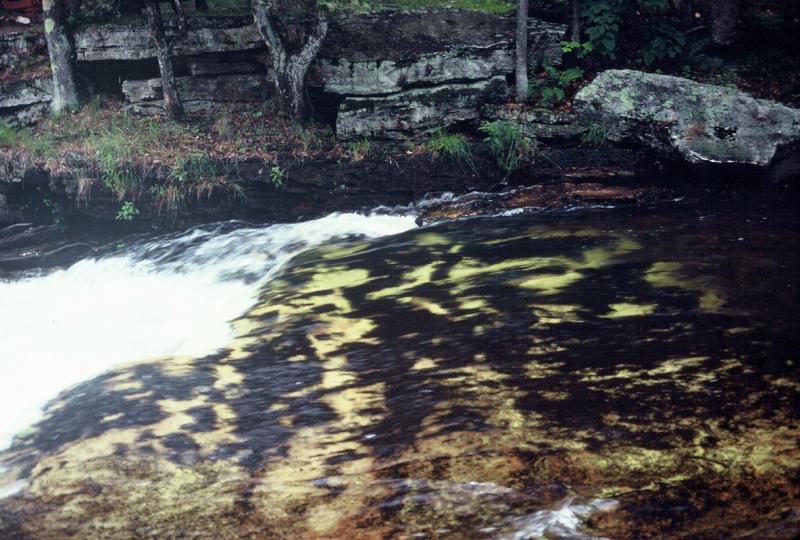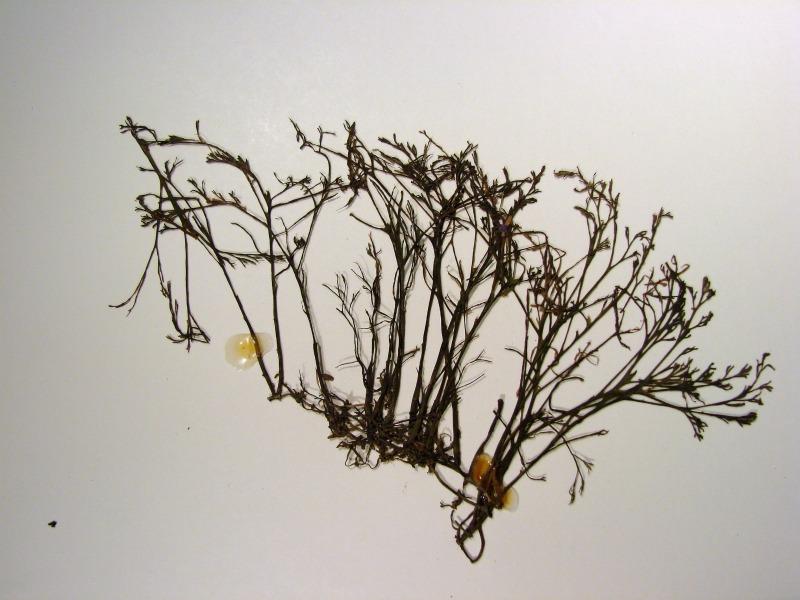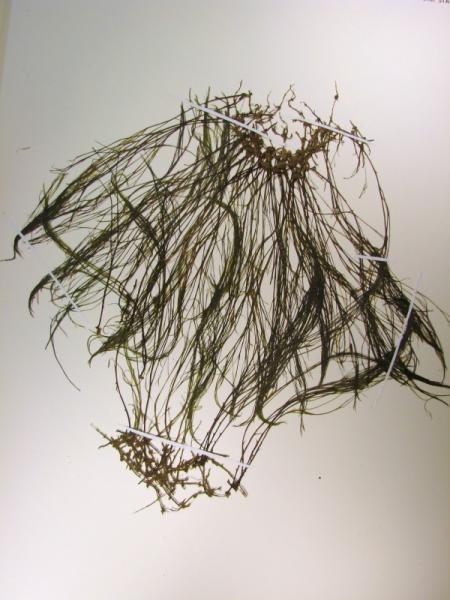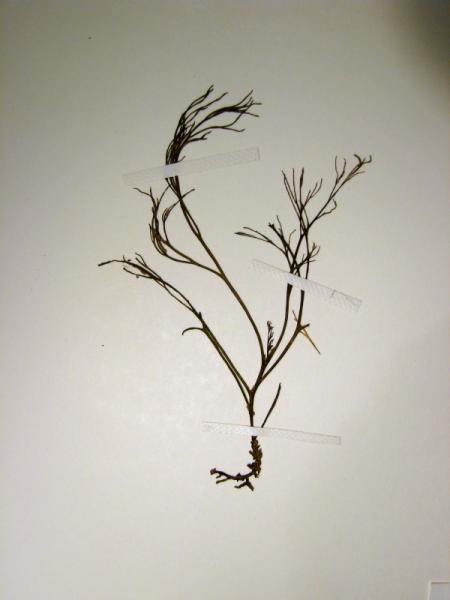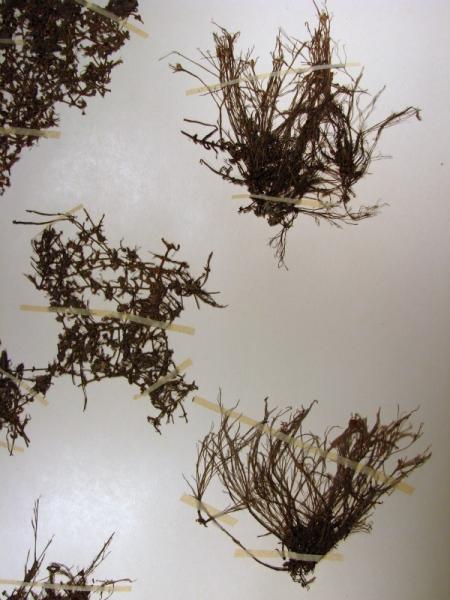Riverweed
Podostemum ceratophyllum Michx.
- Class
- Dicotyledoneae (Dicots)
- Family
- Podostemaceae
- State Protection
- Threatened
Listed as Threatened by New York State: likely to become Endangered in the foreseeable future. For animals, taking, importation, transportation, or possession is prohibited, except under license or permit. For plants, removal or damage without the consent of the landowner is prohibited.
- Federal Protection
- Not Listed
- State Conservation Status Rank
- S2S3
Imperiled or Vulnerable in New York - Very vulnerable, or vulnerable, to disappearing from New York, due to rarity or other factors; typically 6 to 80 populations or locations in New York, few individuals, restricted range, few remaining acres (or miles of stream), and/or recent and widespread declines. More information is needed to assign either S2 or S3.
- Global Conservation Status Rank
- G5
Secure globally - Common in the world; widespread and abundant (but may be rare in some parts of its range).
Summary
Did you know?
This is the only member of this genus and family that occurs in North America. The genus is confined to the New World (Philbrick and Novelo 2004). The genus name Podostemum comes from the greek words for foot and stamen and is in reference to the stamens appearing "raised on a stalk by the side of the ovary" (Fernald 1970). The specific epithet ceratophyllum means horn-leaf (Fernald 1970) and may be in reference to the narrow stiff leaves of this species.
State Ranking Justification
There are 16 known extant populations and 8 populations which have not been seen in recent years and are considered historical. Many of the populations are clustered along particular rivers. Habitat is somewhat limited for this species but certainly not rare.
Short-term Trends
Fifteen out of the 16 known extant populations have first been documented in the past 30 years. This would seem to point to an increase in this species but since this species is often overlooked, resembles algae, and grows in habitat that make it difficult to detect, it is equally possible that these "new" populations were simply overlooked in the past. Overall, short term trends are not clear but probably are at least stable.
Long-term Trends
No population of this species is known to have become extirpated. Eight populations have not been seen in over 25 years. These populations may still be extant, as targeted surveys at these populations have not been conducted. The habitat for this species may have decreased some in the past 100+ years as rivers and streams were developed and/or polluted. Overall long term trends are not clear.
Conservation and Management
Threats
Some of the streams where this species occurs may be used for a water source. This development could result in a change to the stream that would make the habitat less suitable for riverweed. Other populations are threatened by water quality deterioration as a result of development, agriculture, and run off from a sewage treatment plant (New York Natural Heritage Program 2007). Negative impacts on rivers including siltation, nutrient pollution, and dam building have been considered threats to this species (Quiroz et al. 1997 in Philbrick and Novelo 2004).
Conservation Strategies and Management Practices
Water quality of the rivers where this species occurs, should be protected.
Research Needs
Surveys to historical populations are needed to determine if these populations are still extant.
Habitat
Habitat
Riverweed grows submerged (up to 75+ cm deep) to seasonally exposed on cobbles and bedrock substrate in fast flowing, relatively large streams or rivers. It often occurs in rapids (New York Natural Heritage Program 2008). Fast-moving streams, especially rapids (Crow and Hellquist 2000). In rapidly flowing water (Gleason and Cronquist 1991). On rocks in streams (Fernald 1970).
Associated Ecological Communities
- Confined river
(guide)
The aquatic community of relatively large, fast flowing sections of streams with a moderate to gentle gradient.
- Rocky headwater stream
(guide)
The aquatic community of a small- to moderate-sized perennial rocky stream typically with a moderate to steep gradient, and cold water that flows over eroded bedrock, boulders, or cobbles in the area where a stream system originates.
Associated Species
- Cladophora sp.
- Platyhypnidium riparioides
Range
New York State Distribution
In New York, this species occurs in northern New York, including the Adirondacks and southeastern New York, including the Catskills with one population reported from Long Island and one from central New York (New York Natural Heritage Program 2008).
Global Distribution
This species occurs from Nova Scotia and New Brunswick, west to Quebec and southeastern Ontario, and south to Georgia, Louisiana, Arkansas, and Oklahoma. It is disjunct in the Dominican Republic, and Honduras (Philbrick and Novelo 2004).
Identification Comments
General Description
Riverweed is an olive-green, aquatic plant of firm texture that grows in streams and rivers attached to rocks. It resembles seaweed, alga, or moss and attaches to rocks by fleshy disks. The stems are 2-30 cm long and often branched. The leaves are very narrow and divided into numerous linear lobes. The flowers are small, not showy, and scattered along the stems (Fernald 1970, Gleason and Cronquist 1991, Philbrick and Novelo 2004).
Best Life Stage for Proper Identification
It is easiest to identify this plant when it is in flower or fruit although vegetative material, when not confused with alga or moss, is also relatively easy to identify.
Similar Species
This species is perhaps superficially similar to alga and moss but can be distinguished from both by its true although minute flowers, its firm texture, fleshy disks (which attach to the substrate), and stipule-like appendages at the bases of the leaves. The latter three characters will also help separate this species from other aquatic vascular plants.
Best Time to See
Flowers and/or fruits are present from mid-June through early October. Since this species often grows submerged in rapids and fast moving water it can be difficult to spot. Therefore, the best time to survey for this species is between mid-June and early October and when water levels are low.
- Vegetative
- Flowering
- Fruiting
The time of year you would expect to find Riverweed vegetative, flowering, and fruiting in New York.
Riverweed Images
Taxonomy
Riverweed
Podostemum ceratophyllum Michx.
- Kingdom Plantae
- Phylum Anthophyta
- Class Dicotyledoneae
(Dicots)
- Order Podostemales
- Family Podostemaceae
- Order Podostemales
- Class Dicotyledoneae
(Dicots)
- Phylum Anthophyta
Additional Common Names
- Horn-leaved riverweed
- River-moss
- Threadfoot
Synonyms
- Podostemon ceratophyllum Michaux [orthographic variant]
Comments on the Classification
When Michaux (1803) described this genus he used the spelling "Podostemum" in the text and then in a plate illustrating Podostemum ceratophyllum he used the spelling "Podostemon". It appears that Michaux's Podostemon was in error (Sprague 1933) and the family Podostemaceae (based on Podostemum) has been conserved as the correct spelling (McNeill et al. 2006). Podostemon is therefore considered an orthographic variant and is to be replaced by the correct spelling Podostemum.
Additional Resources
Best Identification Reference
Gleason, Henry A. and A. Cronquist. 1991. Manual of Vascular Plants of Northeastern United States and Adjacent Canada. The New York Botanical Garden, Bronx, New York. 910 pp.
Other References
Crow, Garrett E. and C. Barre Hellquist. 2000. Aquatic and Wetland Plants of Northeastern North America: A revised and enlarged edition of Norman C. Fassett's a Manual of Aquatic Plants. Volume One: Pteridophytes, Gymnosperms, and Angiosperms: Dicotyledons. The University of Wisconsin Press. Madison, Wisconsin. 536 Pages.
Fernald, M.L. 1950. Gray's manual of botany. 8th edition. D. Van Nostrand, New York. 1632 pp.
Gleason, Henry A. 1952. The New Britton and Brown Illustrated Flora of the Northeastern United States and Canada.
Haines, Arthur and Thomas F. Vining. 1998. Flora of Maine. A Manual for Identification of Native and Naturalized Vascular Plants of Maine.
Holmgren, Noel. 1998. The Illustrated Companion to Gleason and Cronquist's Manual. Illustrations of the Vascular Plants of Northeastern United States and Adjacent Canada. The New York Botanical Garden, Bronx, New York.
McNeill, J., F.R. Barrie, H.M. Burdet, V. Demoulin, D.J. Hawksworth, K. Marhold, D.H. Nicolson, J. Prado, P.C. Silva, J.E. Skog, J.H. Wiersema, and N.J. Turland (Editors). 2006. International Code of Botanical Nomenclature (Vienna Code) adopted by the Seventh International Botanical Congress Vienna, Austria, July 2005. A.R.G. Gantner Velag, Ruggell, Liechtenstein.
Michaux, A. 1803. Flora boreali-americana, sistens caracteres plantarum quas in America septentrionali collegit et detexit Andreas Michaux. Apud Fratres Levrault, Paris and Strasbourg, France.
New York Natural Heritage Program. 2010. Biotics database. New York Natural Heritage Program. New York State Department of Environmental Conservation. Albany, NY.
New York Natural Heritage Program. 2024. New York Natural Heritage Program Databases. Albany, NY.
Philbrick, C.T. and A. Novelo R. 2004 Monograph of Podostemum (Podostemaceae). Systematic Botany Monographs 70: 1-106.
Reschke, Carol. 1990. Ecological communities of New York State. New York Natural Heritage Program, New York State Department of Environmental Conservation. Latham, NY. 96 pp. plus xi.
Rhoads, Ann F. and Timothy A. Block. 2000. The Plants of Pennsylvania, an Illustrated Manual. University of Pennsylvania Press, Philadelphia, PA.
Sprague, T.A. 1933. Podostemaceae or Podostemonaceae. Bulletin of Miscellaneous Information (Royal Gardens, Kew) 46: 46.
Weakley, A. S. 2007. Flora of the Carolinas, Virginia, Georgia, and surrounding areas. Working draft of 11 January 2007. University of North Carolina Herbarium (NCU), North Carolina Botanical Garden, University of North Carolina at Chapel Hill. Online. Available: http://www.herbarium.unc.edu/flora.htm (accessed 2007).
Weldy, T. and D. Werier. 2010. New York flora atlas. [S.M. Landry, K.N. Campbell, and L.D. Mabe (original application development), Florida Center for Community Design and Research http://www.fccdr.usf.edu/. University of South Florida http://www.usf.edu/]. New York Flora Association http://newyork.plantatlas.usf.edu/, Albany, New York
Weldy, Troy W. and David Werier. 2005. New York Flora Atlas. [S.M. Landry, K.N. Campbell, and L.D. Mabe (original application development), Florida Center for Community Design and Research. University of South Florida]. New York Flora Association, Albany, NY. Available on the web at (http://newyork.plantatlas.usf.edu/).
Links
About This Guide
Information for this guide was last updated on: January 22, 2008
Please cite this page as:
New York Natural Heritage Program. 2024.
Online Conservation Guide for
Podostemum ceratophyllum.
Available from: https://guides.nynhp.org/riverweed/.
Accessed July 27, 2024.
